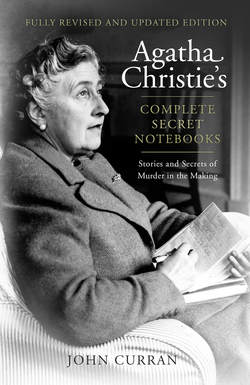Читать книгу Agatha Christie’s Complete Secret Notebooks - Агата Кристи, Agatha Christie, Detection Club The - Страница 17
Plotting
ОглавлениеChristie’s plotting, coupled with this almost uncanny readability, was to prove a peerless combination. An examination of her Notebooks shows that although this gift for plotting was innate and in profusion, she worked at her ideas, distilling and sharpening and perfecting them, and that even the most inspired titles (e.g. Crooked House, Endless Night, The ABC Murders) were the result of meticulous planning. The secret of her ingenuity with plot lies in the fact that this dexterity is not daunting. Her solutions turn on everyday information: some names can be male or female, a mirror reflects but it also reverses, a sprawled body is not necessarily a dead body, a forest is the best hiding place for a tree. She knows she can depend on the reader’s erroneous interpretation of an eternal triangle, an overheard argument or an illicit liaison. She counts on our received prejudice that retired Army men are harmless buffoons, that quiet, mousy wives are objects of pity, that all policemen are honest and all children innocent. She does not mystify us with the mechanical or technical; or insult us with the clichéd or the obvious; or alienate us with the terrifying or the gruesome.
In almost every Christie title the mise-en-scène features a closed circle of suspects: a strictly limited number of potential murderers from which to choose. A country house, a ship, a train, a plane, an island – all of these provided her with a setting that limits the number of possible killers and ensures that a complete unknown is not unmasked in the last chapter. In effect, Christie says, ‘Here is the flock of suspects from which I will choose my villain. See if you can spot the black sheep.’ It can be as few as four (Cards on the Table) or five (Five Little Pigs) or as many as the coach full of travellers on the Orient Express. The Mysterious Affair at Styles is typical of the country-house murders beloved of Golden Age writers and readers: a group of assorted characters sharing an isolated setting long enough for murder to be committed, investigated and solved.
Although an element of the solution in The Mysterious Affair at Styles turns on a scientific fact, it is not unfair as the reader is told from the outset of the investigation what the poison is. Admittedly, anyone with knowledge of toxicology has a distinct advantage, but the information is readily available. Other than this mildly controversial item, all the information necessary to arrive at the solution is scrupulously given: the coffee cup, the scrap of material, a fire lit during a July heatwave, the medicine bottle. And, of course, it is Poirot’s passion for neatness that gives him the final proof; and in a way that was to be reused, a decade later, in the play Black Coffee. But how many readers will notice that Poirot has to tidy the mantelpiece twice (Chapters 4 and 5), thereby discovering a vital link in the chain of guilt?
